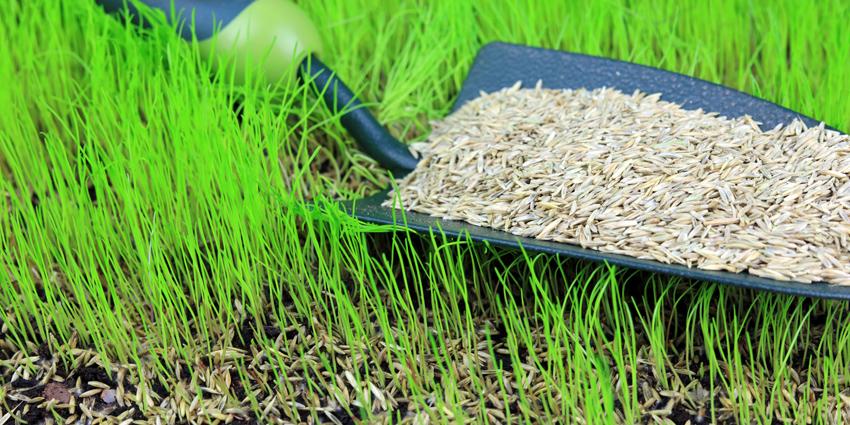
Created By
Matt Adams
Updated On
- February 29, 2024
Get FREE Exclusive Access
Keep your lawn pristine with exclusive tips, offers and insights that I only share with my private subscribers.
Latest Posts
How, why & when to sow grass from seed
- By Matt Adams
- February 29, 2024
Jump to
Get FREE Exclusive Access
Keep your lawn pristine with exclusive tips, offers and insights that I only share with my private subscribers.
Are you renovating your garden and looking to create a nice, green, fresh lawn?
Well you’re in the right place.
In this article I’m giving you all you need to know about sowing your grass seed. This content goes hand-in-hand with my other article ‘How to prepare the ground for turf or seed‘. So, have a read of that too.
Let’s dive right in – starting with ‘WHY choose grass seed’.
Why should you sow grass seed?
It goes without saying, the number one benefit you get from grass seed is the low cost.
Let’s take a look.
The cost of laying turf on a 100m2 lawn is about £1,400 at the low end. The cost of sowing seed on 100m2 is around £50. You can see there’s a huge difference of £1,350.
That’s not the only thing though, with grass seed, you have a much wider choice of types that are more likely to suit your needs.
For example:
If your lawn is in shade or wet, you can buy a premium shade grass seed, Alternatively, if you have pets and kids, then you could choose a hard wearing seed. That’s just 2 examples – there are loads of different types available on the market.
What’s more, by using seed instead of turf, when you need to overseed your lawn, you can be sure to get the right mix of seed which is the same as the one you used previously.
Now you know why, let’s look at when.
When to sow grass seed calendar by month
I’ve also created an easy to read calendar to show you which months are best and which months may require cautionary measures.

When (what time of year) to sow grass seed
You can actually sow grass seed whenever you want but the best time is generally between March & October. And I recommend following these rules.
The best way to know if it’s the right time or not, is to check on the condition of the soil.
The key criteria needed for grass to grow is that the soil needs to be above 8℃, there should be no frost and the soil should remain moist all the time that the grass is germinating.
Now you understand the key criteria, it’s easy to see why Spring (March to May) and Autumn (Sep to Nov) are the best times to get your new lawn into fruition. The fact you need to avoid frost simply rules out doing anything for most of the Winter.
That just leaves the question ‘can I sow grass seed in the Summer’. In short ‘Yes’ you can. However, note that the soil needs to remain moist all the time that your new grass is starting to germinate.
This means if you try to grow seed during the hot summer months, you will need to water the seeded area every day 2-3 times per day for approximately 5-10 minutes. It’s good practice to water in the evening too because the moisture will remain in the soil for longer during the cool night.
Will grass die if it goes down at the wrong time of year?
I often get asked whether their grass seed will die off if they sow it too early in the year. The one thing to remember is that grass seed is very hardy. Meaning it doesn’t just die off easily.
Most of the time, the germination is delayed as opposed to the grass seed actually dying. For example if you put it down in early March, then two weeks later you have a cold snap in your area, the grass seed will just stay dormant and then start growing again when the temps warm up.
The most common time for seed to die off is just after it’s germinated. Though even the smallest of sprouting shoots are fairly hardy enough to survive some tough cold snaps.
This is when they are at the most vulnerable though, when the seed has just started sprouting its little heads. So, this is the time to be most cautious – including walking, watering and protecting from the cold.
Steps for sowing grass from seed
The steps below include a combination of preparing the ground (read this), measuring out the lawn for an even spread and helping it germinate.
Here goes:
- Mark out where you want the edges of the lawn to be (I’ve mainly used bricks before)
- Rotovate the soil down to a minimum of about 15cm
- Get rid of weeds and remove any rubble
- Add top soil (optional)
- Level the seedbed with a rake and a roller
- Sow the seed at our recommended rate depending on the grass seed you purchased (usually 35g per m2)
- Rake over the seed to mix it with the soil
- Flatten the soil bed so it’s flat again (you can do this with either your feet or with a roller)
- Keep the birds off (here are some ideas)
- Monitor daily rainfall – if it rains happy days!
- If no rain, water the seed for 5-10 minutes, twice each day (this is best done in the morning and evening when the soil will hold the water for longer)
Sowing seed by hand vs sowing with a spreader

Image courtesy of gardena.co.uk
Sowing by Hand
If you have a small area to cover, it’s perfectly fine to sow grass seed by hand. But you must measure out the area correctly and weigh the grass seed in line with the recommended application rate for that area.
What’s more, the smaller the section, the more likely you are to make an even spread across the area. For example splitting the area into 5 x 4m2 (20m2) will help to get an even spread more than trying to sow one batch of seed across a 50m2 lawn.
Of course it takes a bit longer to apply when you’re doing smaller sections but the results will be worth it – especially if your applying by hand.
Sowing with a hand-held spreader
If you have a medium to large area to cover, say 200m2, then you’re definitely going to benefit from using a hand spreader.
There are 2 types of hand held spreader. One that looks like a cup with a handle or a slightly larger one that has a manual lever to release the contents.
Try to keep the spreader close to the ground when applying. Especially in windy conditions. That way you can be certain that the seed is going in the areas you want it.
By keeping low, you’ll also reduce the amount of ‘stray’ seed going into the flowerbeds and creating patches of grass in random locations.
Sowing with a wheel spreader
If you’re lawn is over 200m2 then you’ll definitely benefits from a wheel spreader. These spreaders can hold anything from 12 litres upwards of seed.
They also help spread material more evenly across the area. So, you can do a much larger section of the garden with one fill of the spreader.
Note: We always recommend measuring the area and applying the right weight of seed according to the optimum application rate for that product.
Now you know the different ways of applying your seed, it leaves one more question.
Is it worth investing in a seed spreader?
The best thing about a spreader is that you’re not only going to use it once.
If you want your lawn to remain healthy and look good, you’re going to be using a spreader a lot. It’s perfectly fine to use the same equipment for seed as you do for feed and fertiliser. Except the liquid stuff of course, you’ll need a watering can for that. So, with that in mind it’s definitely worth the investment IMHO.
On the other hand, if you’re not looking to continue with your lawn care after sowing your seed, then you may find it better to apply everything by hand.
And therefore you don’t need a spreader. It really depends on your goals and desire to maintain a thick, lush and healthy lawn.
How to care for your lawn after germination
The journey doesn’t stop after sowing your seed or laying your turf. If you want your new grass mat to stand the test of time against weeds and disease, continuing your lawn care is paramount.
If you sow your seed (or lay your turf) in Autumn, you’ll want to continue with a Winter feed and then a light rake (aka scarifying) the following Spring.
If you sow your seed (or lay your turf) in Spring, you can apply a liquid seaweed about 4 weeks after, which will help the soil as much as the lawn.
From there, you can carry on with a year round lawn care as explained in this article.
One thing I usually recommend is to do a light overseed approximately 1 year after sowing new seed. That way, you will fill in any patches and keep the grass as the dominant force among other living things that are fighting for the nutrients in the soil.
If you have any questions or simply enjoyed the read – please drop a comment in the box below. Cheers!

This Post Has 6 Comments
Very interesting and informative read lots of tips
Thanks for your advice Matt
You’ve put me on the right road to
Renovate our old lawn cost effectively.
Great Site
Hi. Great website
Please advise, I have an oval lawn that has a circumference of 26m
Half is in sun and other in shade.
I have prepared it by digging and turning over lawn, adding sand (clay soil), manure and top soil, rotavated and levelled
Please advise what type of seed to sow!
Hi Baldip,
You’re best option would be our premium shade mix. See here
Cheers, Matt
I filled in some low areas in my lawn with top soil in june. I applied a preseed feed and when i applied the seed i put some compost over it. Even now i have bare patches, how should i deal with these now.
A bit of grass seed and some top dressing will do the trick.